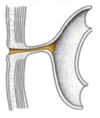Development of the Midgut and Hindgut Flashcards
What does the midgut give rise to?
- Small intestine, including most of the duodenum post bile duct entry
- Caecum and appendix
- Ascending colon
- Proximal 2/3 or transverse colon
Draw a diagram illustrating the position of the midgut in an embryo

What causes the midgut to make a loop?
It elongates enormously, and quickly runs out of space due to the large size of the developing liver
What does the loop made by the midgut have at its axis?
The superior mesenteric artery
What is the loop made by the midgut connected to?
The yolk sac
How is the midgut loop connected to the yolk sac?
By the vitelline duct
What are the limbs of the midgut loop called?
Cranial and caudal limbs
Label this diagram

- A - Cranial limb
- B - Superior mesenteric artery at axis
- C - Caudal limb
- D - Vitelline duct to yolk sac
- SMA
- Cranial
- Caudal
What are the derivatives of the cranial limb?
- Distal duodenum
- Jejunum
- Proximal ileum
What are the derivates of the caudal limb?
- Distal ileum
- Cecum
- Appendix
- Ascending colon
- Proximal 2/3 of transverse colon
What happens to the primary loop during the 6th week of development?
It elongates very rapidly
What happens to the liver during the 6th week of development?
It grows very rapidly
What is the problem with the rapid growth of both the liver and the primary loop?
The abdominal cavity is too small to accomodate both
What is the result of the abdominal cavity being too small too accomodate the primary loop and the liver?
Physiological herniation
What is physiological herniation?
Where the intestines herniate into the proximal umbilical cord, alongside the umbilical vessels
What are the stages in rotation of the midgut loop?
- First rotation
- Second rotation
By how much is the first rotation of the midgut loop?
90 degrees
By how much is the second rotation of the midgut loop?
180 degrees
What happens in the first rotation of the midgut loop?
During herniation into the umbilical cord, the midgut rotates around the axis formed by the SMA in a counter clockwise direction (cranial limb moves to back, caudal to the front)
Draw a diagram illustrating what happens in the first rotation of the midgut loop?

Does elongation of the small intestinal lumen continue during rotation?
Yes
What is the result of the elongation of the small intestinal loop continuing during rotation?
The jejunum and ileum form a number of coiled loops
What happens to the large intestine during rotation?
It lengthens, but does not participate in the coiling phenomenon
When does the second rotation of the midgut loop occur?
When it returns into the abdominal cavity, around week 10
In what direction does the second rotation of the midgut loop occur?
Turns 90 degrees counter-clockwise twice
Draw a diagram illustrating the second rotation of the midgut loop

In total, by how much does the midgut loop rotate?
270 degrees counter-clockwise
Which limb returns to the abdomen first?
The cranial limb
In what direction does the cranial limb move on return to the abdomen?
To the left hand side
What returns to the abdomen last following rotation?
The cecal bud
What happens once the cecal bud has returned to the abdomen?
It descends, moving the ceacum to the right lower quadrant
What does the rotation of the midgut loop account for?
The positions of the small and large intestines, and the twisted apperances of the mesentery of the small intestine
Are abnormalities of rotation common?
Yes
What do abnormalities of rotation cause?
Abnormal positioning of the midgut derivatives, e.g. the appendix on the left
What happens in incomplete rotation?
The midgut only makes one 90 degree rotation
What is the consequence of incomplete rotation?
Left sided colon
Draw a diagram showing the consequence of incomplete rotation

What happens in reversed rotation?
The midgut makes one 90 degree rotation clockwise
What is the consequence of reversed rotation?
The transverse colon passes posterior to the duodenum, and can wrap arround and occlude
Draw a diagram showing the consequences of reversed rotation

What does incomplete or reversed rotation lead to?
Hypermobile guts
What is a volvulus?
A bowel obstruction where a loop of bowel has abnormally twisted in on itself
What makes a volvulus more likely?
Hypermobile guts
What can a volvulus lead to?
- Strangulation
- Ischaemia
What does the hindgut give rise to?
- The distal 1/3 transverse colon
- Descending colon
- Rectum
- Superior part of anal canal
- Epithelium of the urinary bladder
Draw a diagram illustrating the position of the hindgut

What happens to the hindgut at 6 weeks?
It ends in the cloaca
What separates the cloaca from the outside?
The cloacal membrane
What does the cloaca undergo after formation?
An anteroposterior division
What happens in cloacal partitioning?
A wedge of mesoderm grows down into the cloaca











